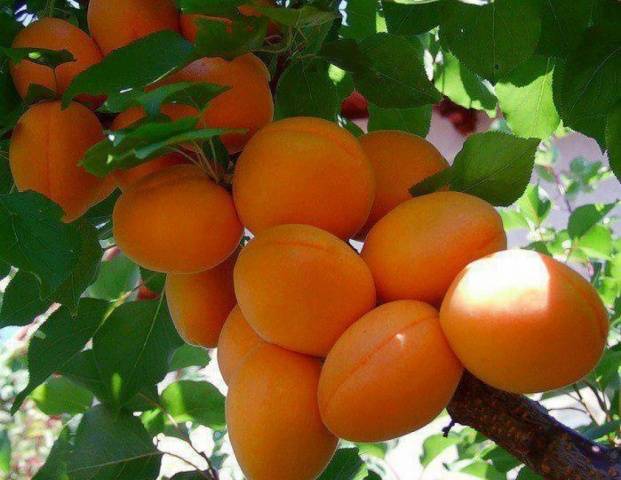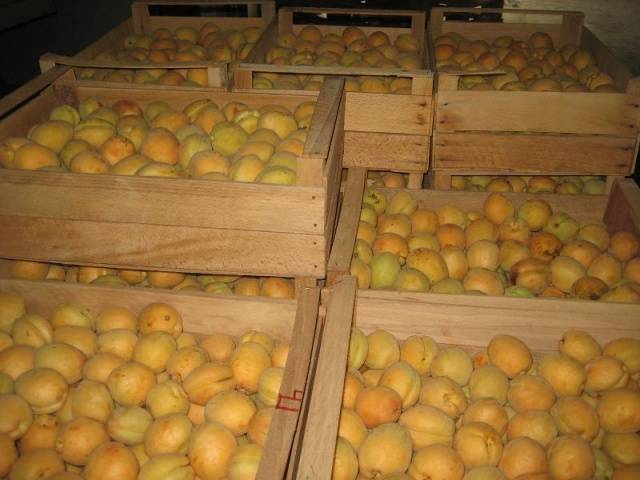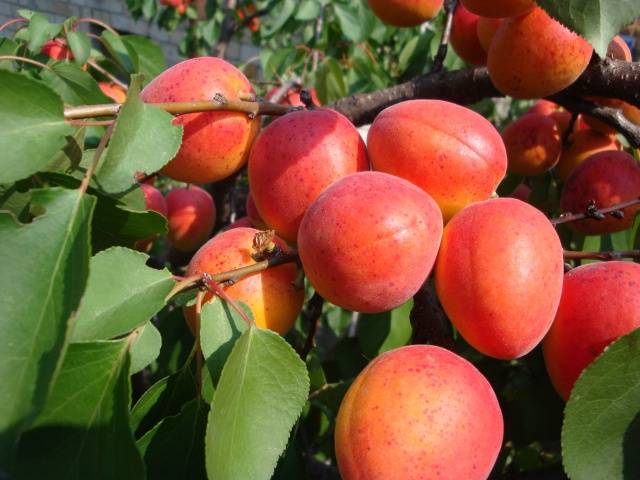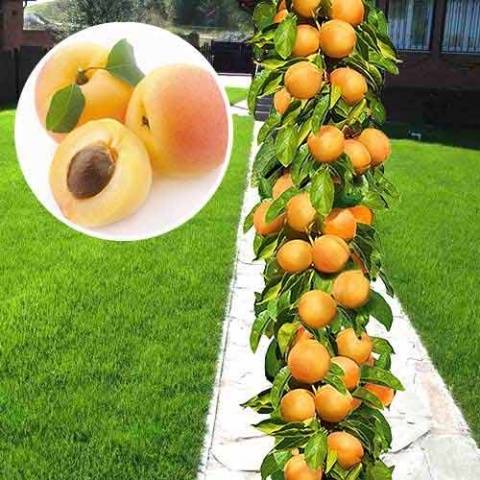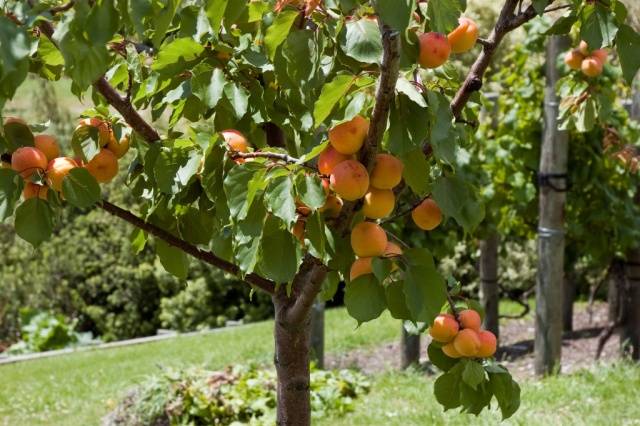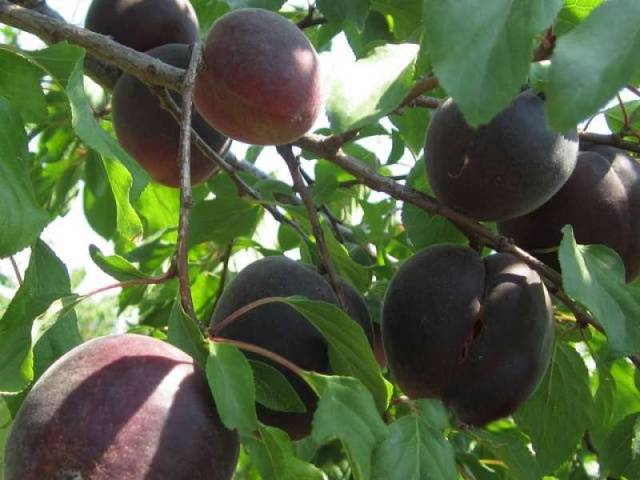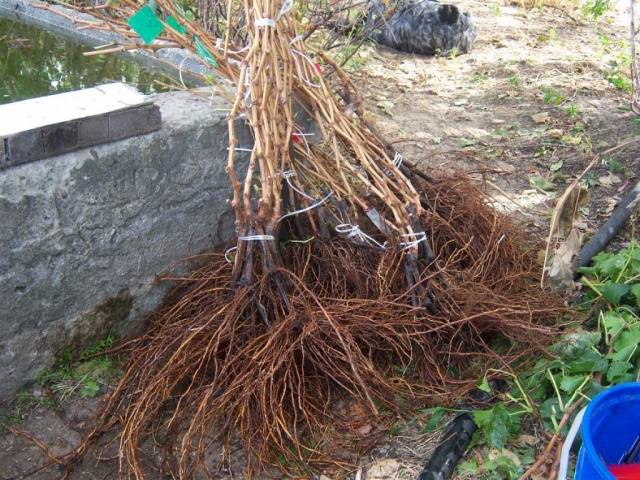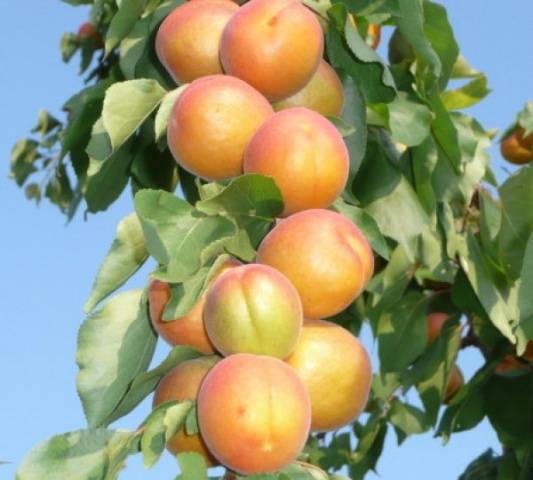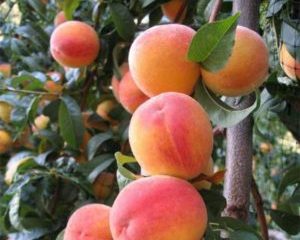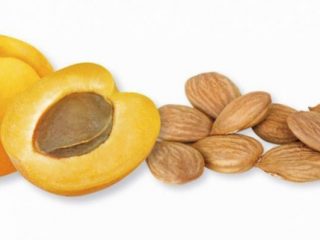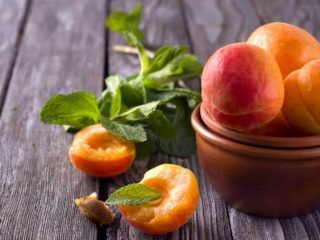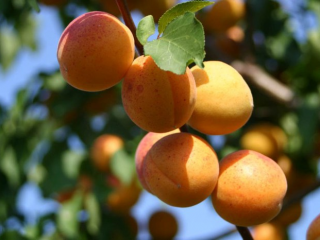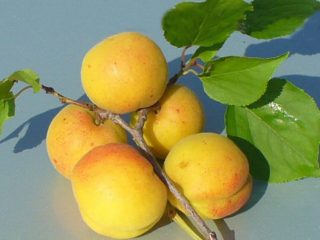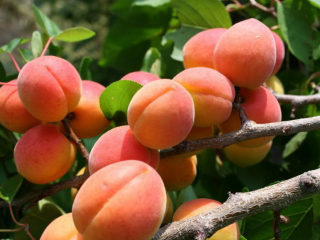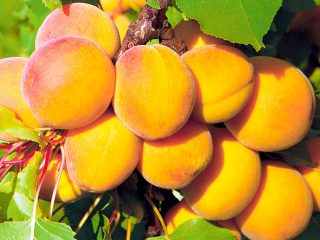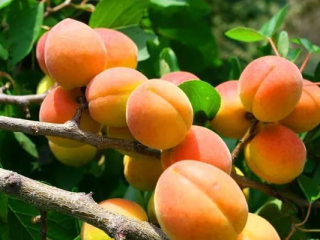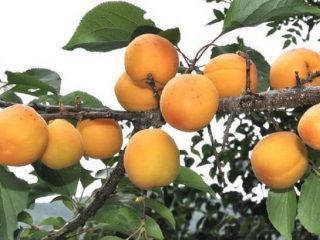Content
- 1 Characteristics of apricot varieties
- 2 The largest varieties of apricot
- 3 Winter-hardy apricot varieties
- 4 Varieties of columnar apricots
- 5 Low-growing apricot varieties
- 6 Self-fertile apricot varieties
- 7 Classification of varieties by ripening time
- 8 Systematization of apricot varieties by fruit color
- 9 How to choose the right variety
- 10 The best apricot varieties for the Moscow region
- 11 Which columnar apricot varieties to choose in Kuban
- 12 The best apricot varieties for Siberia
- 13 The best apricot varieties for the Urals
- 14 The best varieties of apricots for central Russia
- 15 The best varieties of apricots for the Krasnodar region
- 16 Conclusion
- 17 Reviews
Apricot varieties are numerous and varied. According to the State Varietation Commission, 44 types of apricot are grown in Russia, 65 of them are registered in the State Register. In addition, there are quite a lot of hybrids, as well as names not included in the official reference books. This article will help you understand the variety of apricot varieties.
Characteristics of apricot varieties
The classification of apricot varieties is rather arbitrary. However, they are divided according to several criteria.The following groups are distinguished by height and type of tree:
- short (up to 3 m);
- medium height (3–6 m);
- tall (over 6 m);
- columnar.
Apricots are also classified into several groups according to their ripening time:
- early (late June – early July);
- mid-early (July 05–15);
- mid-late (July 15–25);
- later (later July 25).
It should be noted that the classification of apricots according to ripening dates may not be the same in different regions. The same variety, depending on weather conditions, will bear fruit either earlier or later. For example, in Central Asia, apricots ripen almost a month earlier than the same varieties in Crimea.
According to the purpose of the fruit, all varieties of apricots are divided into the following:
- canteens;
- canning;
- universal;
- drying
Table varieties have low shelf life and are consumed mainly fresh. Canned varieties are more suitable than others for industrial processing, for example, for making juice, apricots in their own juice or jam. Drying varieties have increased sugar content and are used mainly for the production of dried apricots. Universal varieties can be used for any purpose.
Apricots do not have a clear classification based on the color and size of the fruit. Their color can vary from almost white to almost black. However, most varieties have bright yellow or orange fruit. The size of the fruit depends not only on the variety, but also on proper agricultural technology, weather conditions, etc. The standard division of apricot varieties by fruit size is as follows:
- very small (up to 10 g);
- small (10–20 g);
- medium (20–30 g);
- above average (31–40 g);
- large (41–60 g);
- very large (over 60 g).
Apricot is a southern plant, so the concept of frost resistance appeared only after the development of varieties suitable for cultivation in more northern regions. In the wild, there are such frost-resistant species as Manchurian apricot and Siberian apricot, and they have become the basis for the selection of cold-resistant varieties.
The largest varieties of apricot
Among the large-fruited varieties with a fruit weight of 40 g and above, it is worth noting the following:
- Peran.
- Big early.
- Shalah.
- Dawn of the East.
- Farmingdale.
- Olympus.
- Aviator.
- Red Crimea.
- Hope.
- Russian.
The last four varieties on this list are characterized by increased winter hardiness.
Winter-hardy apricot varieties
Apricots from this list are characterized by increased resistance to low temperatures. Moreover, not only the trees themselves are frost-resistant, but also their buds, which are often more prone to freezing.
Among the winter-hardy varieties, the following varieties can be distinguished:
- Cupid hybrid
- Bai
- Hardy.
- Innokentyevsky.
- Red-cheeked.
- Darling.
- Honey.
- Monastic.
- Partisan highland.
- Russian.
- Snigirek.
- Spassky.
- Triumph Northern.
- Ussuri
Of this list, the Red-cheeked apricot is the most famous and long-cultivated variety. More than 70 years have passed since its breeding, and it still enjoys the love and respect of gardeners.
The following hybrids were bred on the basis of Red-cheeked:
- Red-cheeked Salgirsky.
- Son of Red-cheeked.
- Nikitsky.
- Nikolaevsky.
Partisan alpine is the most frost-resistant variety known, its winter hardiness is -50 degrees Celsius.
Varieties of columnar apricots
Columnar trees are the latest achievement of breeders.Such fruit crops take up much less space than ordinary trees due to their compactly formed crown, reminiscent of a column. Usually its height does not exceed 2.5–3 m, and its width is 0.3–0.5 m.
Despite their compact size, the yield of columnar fruit trees is not inferior to other, conventional varieties. The most famous columnar apricot varieties are listed below.
- Sunny, or Sunny Summer. Apricot is medium-sized, about 2.5 m high. Self-sterile, requires nearby pollinating neighbors. Winter hardiness is good, down to -35 °C. Fruiting is extended, occurring in August. The fruits are large, weighing 40–60 g, bright orange, golden, with a characteristic blush. Productivity from one tree is up to 15 kg.
- Gold (Gold). Self-fertile variety of mid-early ripening. Tree height is up to 2.5 m. Winter hardiness is above average, up to -35 °C. The fruits ripen in early August. Ripe apricots have an elongated shape, a bright yellow color and a diffuse pink blush. Fruit weight 50–55 g.
- Star. Large-fruited variety, average fruit weight is about 60 g, fruits of 80–100 g are also found. The tree is self-fertile. Ripens quite late, at the end of August. Apricots are yellow in color, juicy, with thin skin and very aromatic pulp. The yield is about 10 kg per tree.
- Prince Mart (Prince). Winter-hardy variety with consistently high yields. Self-fertile. Ripens in late July – early August. The fruits are bright orange, uneven in size and weight, from 30 to 60 g. The tree is small in height, its maximum size is 2 m.
Columnar apricots require constant pruning to maintain their shape. Without it, the tree will soon turn into an ordinary one.
Low-growing apricot varieties
Compact, low varieties of apricots are valued by many precisely for their size, which allows them to harvest without the use of special equipment. In addition, these trees take up much less space in the garden, which is important in conditions of limited space.
Low-growing varieties of apricots usually include those whose height does not exceed 2.5 m. This height allows you to reach the top branches from the ground without the help of stepladders and stands. Low-growing apricots include:
- Snowfinch.
- Cup.
- Black mouse.
Their compact shape and small size make it possible to completely cover the tree for the winter, so they can be grown even in areas with an unfavorable climate.
Self-fertile apricot varieties
Self-fertility, or the ability to self-pollinate, is a very important quality of apricots, especially for cultivation in the northern regions. Apricot blooms quite early (late April - early May), and most insects that pollinate the plants are inactive at this time.
Among the many varieties of apricots there are both self-fertile and self-sterile. Self-fertile varieties include:
- Pineapple.
- Hardy.
- Dessert.
- Red-cheeked.
- Lel.
- Melitopol early.
- Rattle.
- Sardonyx.
- Snowfinch.
- Northern Triumph.
- Tsarsky.
Self-fertile plants do not pollinate 100% of their flowers. It must be remembered that the presence of pollinating neighbors in such trees can increase the yield by 2–3 times.
Classification of varieties by ripening time
Traditionally, all apricots are divided according to ripening periods into early, mid-ripening and late. In addition, there are also ultra-early varieties (ripening at the end of May), as well as varieties with extended fruiting, making it difficult to classify them on this basis.
Early ripening
These include apricots, which ripen in June. These are the following:
- Apricot Early.
- Alyosha.
- June.
- Melitopol early.
Early apricots allow you to harvest in early summer. However, we must remember that such trees bloom very early, so the risk of flowers freezing when grown in an unfavorable climate is very high.
Mid-season
The ripening period for mid-season apricots is the second half of July and the beginning of August. These include:
- Academician.
- Veteran of Sevastopol.
- Red-cheeked.
- Royal.
- Monastic.
- Olympus.
- Oryol resident.
- Polesie large-fruited.
- Shelah (Yerevani).
- Yalta resident.
Late apricot varieties
Late varieties of apricots ripen at the end of August, and under unfavorable weather conditions this period can extend until mid-September. The later ones include:
- Spark.
- Red-cheeked Nikitsky.
- Red partisan.
- Kostyuzhensky.
- Melitopol late.
- Denisyuk's special.
- Favorite.
- Edelweiss.
The fruits of late varieties of apricots have good transportability, are well stored and do not lose their attractive appearance for a long time.
Systematization of apricot varieties by fruit color
Most apricot fruits are bright yellow or orange. However, other colors are also found, such as white, red and black.
Black apricot varieties
Dark-colored hybrids appeared as a result of cross-pollination of apricot and cherry plum growing nearby. Such trees have fruits of a dark purple or dark lilac color, and they have a very weak velvety characteristic of ordinary apricots.
The most famous varieties of black apricot are:
- Black Prince.
- Black velvet.
- Melitopol.
- Korenevsky.
- Little mouse.
- Lugansk.
Gardeners are almost unanimous in the opinion that ripe black apricots in fresh form are inferior to classic apricots in taste and aroma, but when canned they are significantly superior to them.
Red-fruited apricots
Red-fruited varieties are usually called varieties in which a bright red blush occupies most of the fruit. These include the following apricots:
- Red partisan.
- Red-cheeked late.
- Nakhichevan red.
- Nowrast is red.
- Russian-Bulgarian.
Most of these varieties are suitable for cultivation only in areas with a warm climate, because due to the abundance of sun, this characteristic “blush” is formed on the fruits.
How to choose the right variety
Choosing the right variety for planting is a real challenge, especially for an inexperienced gardener. The further north the growing area, the more nuances need to be taken into account and the more work will have to be done to get a harvest. A mistake in choice can be very expensive.
Most apricots begin to bear fruit only 4-5 years after planting. The wrong choice can lead to the fact that the tree simply does not bear fruit, spending all its energy on the constant struggle for survival. In the end, the plant will die or the gardener will get rid of it himself, without waiting for the harvest and thus wasting several years.
The best apricot varieties for the Moscow region
When choosing an apricot for planting in the Moscow region, you need to take into account several nuances. First of all, this is the location of the landing site. Apricot will not grow in a swampy lowland, on heavy clay or on the north side of the garden, in a windswept area or in the shade of a large building.
When choosing seedlings, you should give preference to zoned varieties.They were bred specifically for the conditions of the Moscow region, therefore, they are maximally adapted for landing in this region.
Many gardeners in the Moscow region graft apricot onto a more winter-hardy plum. This technique allows you to avoid the biggest problem of apricot orchards in the Moscow region - warming of the bark. The grafting is done on a plum trunk at a height of 1.2–1.3 m.
The best columnar apricot varieties for the Moscow region
More and more gardeners are giving preference to columnar types of fruit trees. And apricot is no exception here. Few summer residents near Moscow can boast of a large plot size, and columnar trees are ideally suited for cultivation in conditions of land shortage.
Working with a small tree is much easier, and covering it for the winter is not difficult. Therefore, the chances of a harvest are much greater. The best columnar apricots for the Moscow region are Zvezdny and Prince, described above.
Self-fertile apricot varieties for the Moscow region
Self-fertility again partially solves the eternal problem of summer residents in the Moscow region - lack of space. A self-pollinating tree does not require pollinating neighbors. Here are some of the self-fertile apricots recommended for cultivation in this region:
- Lel. The undoubted leader among gardeners in the Moscow region, bred in 1986 in Russia. Early ripening self-fertile variety. The tree grows up to 3 m in height. The fruits are orange, weighing about 20 g. Fruiting is abundant and annual, starting 3, less often 4 years from the moment of planting. Winter hardiness is good, down to -30 °C.
- Snowfinch. This apricot tree grows to a height of only 1.5 m, which makes caring for it much easier. The fruits are medium-sized, 15–18 g, cream-colored with a dark red blush.Productivity 7–15 kg per tree. Frost resistance is good, up to -42 °C. Late flowering and frost resistance allow fruit to set even during return frosts. Ripens in the second half of August.
- Northern Triumph. Although this variety is recommended for cultivation in the Central Black Earth Region, it is also successfully grown in the southern regions of the Moscow region. The apricot tree of this variety is quite large and spreading. The fruits are large, 50–55 g. The yield is high.
- Red-cheeked. This apricot tree is the largest on this list. The fruits are orange, velvety, weighing about 50 g. The tree begins to bear fruit at 3–4 years old, the yield is high.
Winter-hardy apricot varieties for the Moscow region
The leader among the most winter-hardy apricots recommended for planting in the Moscow region is Snegirek, already mentioned in the previous part. Red-cheeked also has good winter hardiness. In addition to those listed, the following varieties have good winter hardiness:
- Alyosha.
- Aquarius.
- Hardy.
- Countess.
- Darling.
- Honey.
- Russian.
The apricot variety Chashechka, one of the shortest among all, also has good winter hardiness.
Which columnar apricot varieties to choose in Kuban
The climate of Kuban is much warmer than in the Moscow region. Negative temperatures are rare for this region, and long-term frosts do not occur.
Any of the above varieties of columnar apricots are suitable for growing in such conditions: Zvezdny, Prince Mart, Sunny or Gold.
The best apricot varieties for Siberia
The sharply continental climate of Siberia is very peculiar. It is characterized by short, dry, hot summers, cool off-seasons, and severe frosty winters, often with minimal snow. Few fruit trees will feel good in such conditions. However, even here you can grow apricots.
short
These include apricots, whose tree height does not exceed 3 meters. These include the following:
- Sayan. An adult tree of this variety has a height of about 3 m. It blooms at the end of May. The average fruit weight is 20 g. Productivity is about 15 kg per tree.
- Mountain Abakan. Compact tree with a spherical crown. Height is about 3 m. Frost resistance is high. The fruits are medium-sized, about 20–30 g, orange, with a blurred blush. Universal purpose. Productivity – 15–18 kg per tree.
- Northern lights. It is a low compact tree. The fruits weigh 25–30 g, the harvest ripening period is the second half of August. Productivity is about 13–15 kg per tree. Self-sterile, requires pollinators.
Winter-hardy
All Siberian varieties have increased resistance to frost. Here are some of these varieties:
- Siberian Baikalova. Tall (up to 4 m) tree with a wide crown. Blooms in the second decade of May. Self-sterile species requiring a pollinator plant. With good agricultural technology, it produces 15–25 kg of fruit from one tree. The average fruit weight is 27–35 g.
- East Siberian. Tree 3–3.5 m high. Ripening period: early, second half of July. The fruits are yellow, from 35 to 70 g. Productivity is 15–17 kg per tree.
- Eastern Sayan. Partially self-fertile variety with medium ripening period. Productivity 11–15 kg per tree.
The best apricot varieties for the Urals
Most of the Ural apricot varieties were bred at the South Ural Research Institute of Fruit and Vegetable and Potato Growing. Here are some of them:
- Chelyabinsk early. Medium-sized compact tree. The crown is medium leafy. The fruits are small, 15–16 g. Universal.Self-fertility is partial.
- Spicy. Medium-sized tree. Fruits 15–16 g, yellow. Partially self-fertile, versatile, high yield.
- Snezhinsky. A tree of medium height with a loose crown. The fruits are small, 20–25 g, bright yellow with red dots. Partially self-fertile. Fruiting begins at 4 years of age.
- Uralets. The tree is small in height, has medium foliage and spreading habit. The fruits are small, 15–17 g, yellow in color with a red dot. Partially self-fertile. Productivity is high. Winter hardiness and drought resistance are good.
- Kichiginsky. Tree of medium height. Fruits are 12–15 g, small, yield up to 15 kg. Self-sterile, requires pollinators.
The best varieties of apricots for central Russia
Many varieties of apricots were bred for central Russia. Here are some recommended for cultivation in this region:
- Amber of the Volga region. Medium sized tree. The fruits are yellow, even in color, weighing 20–25 g. Ripening period is early August. Resistance to frost is high, resistance to drought is average. Self-fertility has not been studied. Productivity is highly dependent on weather conditions and can range from 10 to 44 kg per tree.
- Tsarsky. This apricot can be grown not only in central Russia, but throughout the entire Central region. Tree 3–4 m high. Fruits weigh 20–25 g, yellow. Productivity is average. Frost resistance is high.
- Favorite. The tree is medium-sized, about 4 m high. The fruits are medium-sized, weighing about 30 g, bright yellow in color with a beautiful blush. The main disadvantage is late ripening. Often, due to a bad summer, part of the crop does not have time to ripen, and therefore the yield is average.
- Ulyanikhinsky. The tree is vigorous. The fruits are yellow, 28–32 g, universal in use. Ripen at the end of July.Productivity is good.
- Son of the red-cheeked one. A well-known hybrid obtained from the Red-cheeked apricot. A vigorous tree with a dense, developed crown. The fruits are medium, 30–35 g in weight, the color of the fruit is orange with blush. Ripens at the end of July. Productivity greatly depends on the weather and wintering conditions; it can range from 4 to 30 kg per tree.
- Samara. Tree of medium height. The crown is small, weakly leafy. The fruits are yellow, small, 17–20 g. Frost-resistant. Partially self-fertile. The yield of an adult tree can be up to 50 kg.
- Firstborn of Samara (Kuibyshevsky early). Tall tree up to 5.5 m. The crown is rounded, wide, foliage is strong. The fruits are light orange, one-dimensional, 18–22 g. Ripening period is the third ten days of July. The variety is self-sterile and requires pollinators. Productivity is 15–40 kg per tree.
- Iceberg. The tree is small, up to 3 m, compact. Fruits 20–22 g, orange-yellow, dotted blush. Winter hardiness is good.
- Zhigulevsky souvenir. A small tree up to 4 m. The harvest can be harvested at the end of July, the weight of the fruit is 25–30 g. The color is yellow. Productivity under favorable weather conditions can reach up to 45 kg per tree.
Self-fertile
Among the self-fertile varieties of apricots suitable for cultivation in central Russia, we can distinguish the already mentioned self-fertile species for the Central region:
- Hardy.
- Lel.
- Red-cheeked.
- Dessert.
- Northern Triumph.
- Snowfinch.
The best varieties of apricots for the Krasnodar region
The Krasnodar Territory is a unique territory with many climatic zones due to the difference in altitude above sea level. Among the species recommended for cultivation in this region, there are also strictly zoned ones, suitable for cultivation only in mountain valleys.
- Esdelik (alasha). A weak-growing tree, not exceeding 2–2.5 m. Ripens in early August. The fruits are medium to large (35–50 g), greenish-cream in color. Productivity up to 25 kg per tree.
- Shindakhlan. A vigorous tree with a wide, leafy crown. The fruits are large, cream-colored with a slight pink blush, average weight 45–50 g. The ripening period strongly depends on vertical zonation, and therefore extends from the end of June to the beginning of August.
- Black velvet. A medium-sized tree with a flat-rounded crown of medium density. The fruits are dark purple, with an average weight of 30 g. The ripening period is average, the end of July. Self-fertility is partial. Frost resistance is high, drought resistance is average.
- Honobach. A vigorous tree with a densely leafy spherical crown. The fruits weigh about 25 g, orange with a slight blush. The variety is early, the harvest can be harvested already in the first ten days of July. A special feature of the variety is its strict zoning; it grows well only in mountain valleys.
- Tamasha. Medium-sized tree with a spherical crown. The fruits are medium in size (30–40 g), bright yellow, with a slight blush. Ripens early, in the last ten days of June. Winter hardiness is good, productivity is high.
- Stavropol youth. The tree is average or slightly above average, with good foliage. The fruits are large, up to 50 g, light yellow in color, universal purpose. Partially self-fertile, ripens at the end of July.
- Advertising. Large powerful tree. The fruits are large, 40–50 g. The yield is very high, a tree 15–18 years old can produce 70–90 kg of fruit. Self-sterile, requires pollinators. Winter hardiness is good.
Late apricot varieties for the Krasnodar region
- Spark. The height of the tree reaches 4 m. The crown is medium dense.The fruits are bright orange, with a beautiful blush. Universal purpose of fruits. Frost resistance is good.
- Krasnodar late. The tree is medium-sized, with a flat crown. Fruits weighing about 30 g, yellow, with a slight blush, universal purpose. Ripening period is late. Productivity is high.
- Favorite. Tree of medium height, up to 4 m. Compact crown. Fruits 30–35 g, orange with a large blush. Frost resistance and yield are good.
Conclusion
The varieties of apricots suitable for cultivation in Russia are not limited to the types presented in this article. There are a large number of hybrids of foreign selection, which can also be successfully grown in our climate. This especially applies to the southern regions of the country.
A good video about the intricacies of growing apricots in the Moscow region can be viewed at the link below.
